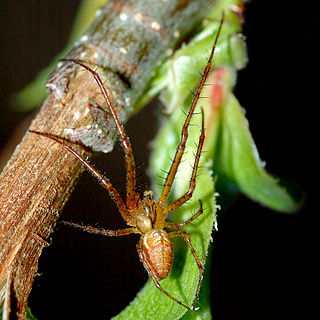
The family Dipluridae, known as curtain-web spiders are a group of spiders in the infraorder Mygalomorphae, that have two pairs of booklungs, and chelicerae (fangs) that move up and down in a stabbing motion. A number of genera, including that of the Sydney funnel-web spider (Atrax), used to be classified in this family but have now been moved to Hexathelidae.

Oonopidae, also known as goblin spiders, is a family of spiders consisting of over 1,600 described species in about 113 genera worldwide, with total species diversity estimated at 2000 to 2500 species. The type genus of the family is OonopsKeyserling, 1835.

Pirate spiders, members of the family Mimetidae, are araneomorph spiders which typically feed on other spiders.

Long-jawed orb weavers or long jawed spiders (Tetragnathidae) are a family of araneomorph spiders first described by Anton Menge in 1866. They have elongated bodies, legs, and chelicerae, and build small orb webs with an open hub with few, wide-set radii and spirals with no signal line or retreat. Some species are often found in long vegetation near water.

Wandering spiders (Ctenidae) are a family of spiders that includes the Brazilian wandering spiders. These spiders have a distinctive longitudinal groove on the top-rear of their oval carapace similar to those of the Amaurobiidae. They are highly defensive and venomous nocturnal hunters. Wandering spiders are known to hunt large prey, for example hylid species Dendropsophus branneri. Despite their notoriety for being dangerous, only a few members of Phoneutria have venom known to be hazardous to humans, but the venoms of this family are poorly known, so all larger ctenids should be treated with caution.

Zoropsidae, also known as false wolf spiders for their physical similarity to wolf spiders, is a family of cribellate araneomorph spiders first described by Philipp Bertkau in 1882. They can be distinguished from wolf spiders by their two rows of eyes that are more equal in size than those of Lycosidae.

Dictynidae is a family of cribellate, hackled band-producing spiders first described by Octavius Pickard-Cambridge in 1871. Most build irregular webs on or near the ground, creating a tangle of silken fibers among several branches or stems of one plant.

Idiopidae, also known as armored trapdoor spiders, is a family of mygalomorph spiders first described by Eugène Simon in 1889. They have a large body similar to tarantulas.

Barychelidae, also known as brushed trapdoor spiders, is a spider family with about 300 species in 42 genera.

Tetrablemmidae, sometimes called armored spiders, is a family of tropical araneomorph spiders first described by Octavius Pickard-Cambridge in 1873. It contains 126 described species in 29 genera from southeast Asia, with a few that occur in Africa and Central and South America. Pacullidae was incorporated into this family in 1981, but was later restored as a separate family in a 2016 phylogenetic study.

Stenochilidae is a family of southeast Asian araneomorph spiders that produce ecribellate silk. First described by Tamerlan Thorell in 1873, it now contains twelve described species in two genera.

Mysmenidae is a spider family with about 135 described species in thirteen genera. The family is one of the least well known of the orb-weaving spiders because of their small size and cryptic behaviour. These spiders are found in humid habitats such as among leaf litter and in caves.

Poecilotheria is a genus of tarantulas native to India and Sri Lanka. It was first described by Eugène Louis Simon in 1885. They are arboreal tarantulas, commonly known as ornamental tarantulas, known for their vivid color patterns, fast movement, and potent venom compared to other tarantulas. As of 2019 all species are protected under CITES.
Wildlife of Sri Lanka includes its flora and fauna and their natural habitats. Sri Lanka has one of the highest rates of biological endemism in the world.

Udubidae is a family of araneomorph spiders, most of whose members were formerly placed in the family Zorocratidae, which is no longer accepted.
Indothele is a genus of Asian spiders in the family Ischnothelidae. It was first described by F. A. Coyle in 1995.
Ischnothelidaeis a family of mygalomorph spiders. It was first described as a subfamily of the family Dipluridae by F.O. Pickard-Cambridge in 1897 and raised to a family by Opatova et al. in 2020. They are also known as scatter-web spiders.













